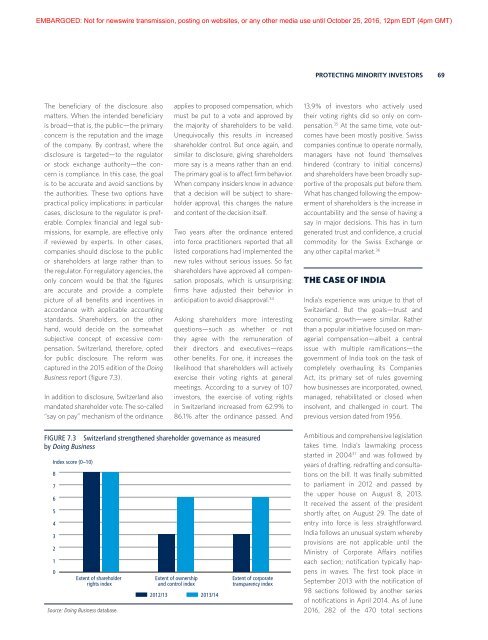49709doing-worldbank
49709doing-worldbank
49709doing-worldbank
You also want an ePaper? Increase the reach of your titles
YUMPU automatically turns print PDFs into web optimized ePapers that Google loves.
EMBARGOED: Not for newswire transmission, posting on websites, or any other media use until October 25, 2016, 12pm EDT (4pm GMT)<br />
PROTECTING MINORITY INVESTORS<br />
69<br />
The beneficiary of the disclosure also<br />
matters. When the intended beneficiary<br />
is broad—that is, the public—the primary<br />
concern is the reputation and the image<br />
of the company. By contrast, where the<br />
disclosure is targeted—to the regulator<br />
or stock exchange authority—the concern<br />
is compliance. In this case, the goal<br />
is to be accurate and avoid sanctions by<br />
the authorities. These two options have<br />
practical policy implications: in particular<br />
cases, disclosure to the regulator is preferable.<br />
Complex financial and legal submissions,<br />
for example, are effective only<br />
if reviewed by experts. In other cases,<br />
companies should disclose to the public<br />
or shareholders at large rather than to<br />
the regulator. For regulatory agencies, the<br />
only concern would be that the figures<br />
are accurate and provide a complete<br />
picture of all benefits and incentives in<br />
accordance with applicable accounting<br />
standards. Shareholders, on the other<br />
hand, would decide on the somewhat<br />
subjective concept of excessive compensation.<br />
Switzerland, therefore, opted<br />
for public disclosure. The reform was<br />
captured in the 2015 edition of the Doing<br />
Business report (figure 7.3).<br />
In addition to disclosure, Switzerland also<br />
mandated shareholder vote. The so-called<br />
“say on pay” mechanism of the ordinance<br />
applies to proposed compensation, which<br />
must be put to a vote and approved by<br />
the majority of shareholders to be valid.<br />
Unequivocally this results in increased<br />
shareholder control. But once again, and<br />
similar to disclosure, giving shareholders<br />
more say is a means rather than an end.<br />
The primary goal is to affect firm behavior.<br />
When company insiders know in advance<br />
that a decision will be subject to shareholder<br />
approval, this changes the nature<br />
and content of the decision itself.<br />
Two years after the ordinance entered<br />
into force practitioners reported that all<br />
listed corporations had implemented the<br />
new rules without serious issues. So far,<br />
shareholders have approved all compensation<br />
proposals, which is unsurprising:<br />
firms have adjusted their behavior in<br />
anticipation to avoid disapproval. 34<br />
Asking shareholders more interesting<br />
questions—such as whether or not<br />
they agree with the remuneration of<br />
their directors and executives—reaps<br />
other benefits. For one, it increases the<br />
likelihood that shareholders will actively<br />
exercise their voting rights at general<br />
meetings. According to a survey of 107<br />
investors, the exercise of voting rights<br />
in Switzerland increased from 62.9% to<br />
86.1% after the ordinance passed. And<br />
13.9% of investors who actively used<br />
their voting rights did so only on compensation.<br />
35 At the same time, vote outcomes<br />
have been mostly positive. Swiss<br />
companies continue to operate normally,<br />
managers have not found themselves<br />
hindered (contrary to initial concerns)<br />
and shareholders have been broadly supportive<br />
of the proposals put before them.<br />
What has changed following the empowerment<br />
of shareholders is the increase in<br />
accountability and the sense of having a<br />
say in major decisions. This has in turn<br />
generated trust and confidence, a crucial<br />
commodity for the Swiss Exchange or<br />
any other capital market. 36<br />
THE CASE OF INDIA<br />
India’s experience was unique to that of<br />
Switzerland. But the goals—trust and<br />
economic growth—were similar. Rather<br />
than a popular initiative focused on managerial<br />
compensation—albeit a central<br />
issue with multiple ramifications—the<br />
government of India took on the task of<br />
completely overhauling its Companies<br />
Act, its primary set of rules governing<br />
how businesses are incorporated, owned,<br />
managed, rehabilitated or closed when<br />
insolvent, and challenged in court. The<br />
previous version dated from 1956.<br />
FIGURE 7.3 Switzerland strengthened shareholder governance as measured<br />
by Doing Business<br />
Index score (0–10)<br />
8<br />
7<br />
6<br />
5<br />
4<br />
3<br />
2<br />
1<br />
0<br />
Extent of shareholder<br />
rights index<br />
Source: Doing Business database.<br />
Extent of ownership<br />
and control index<br />
2012/13 2013/14<br />
Extent of corporate<br />
transparency index<br />
Ambitious and comprehensive legislation<br />
takes time. India’s lawmaking process<br />
started in 2004 37 and was followed by<br />
years of drafting, redrafting and consultations<br />
on the bill. It was finally submitted<br />
to parliament in 2012 and passed by<br />
the upper house on August 8, 2013.<br />
It received the assent of the president<br />
shortly after, on August 29. The date of<br />
entry into force is less straightforward.<br />
India follows an unusual system whereby<br />
provisions are not applicable until the<br />
Ministry of Corporate Affairs notifies<br />
each section; notification typically happens<br />
in waves. The first took place in<br />
September 2013 with the notification of<br />
98 sections followed by another series<br />
of notifications in April 2014. As of June<br />
2016, 282 of the 470 total sections


